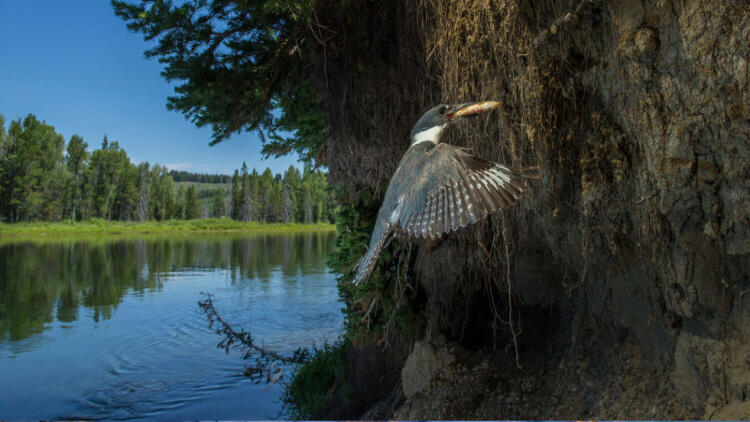Think those gorgeous National Geographic photos happen easily? Photographer Charlie Hamilton James breaks down a recent shoot of a belted kingfisher—and all the work that went in to getting the perfect shot I’m obsessed with kingfishers. I have been since I was seven years old, and to date I have shot and written two books on them, as well as one National Geographicmagazine article. So when I find a belted kingfisher nest on a recent assignment for National Geographic in Wyoming—there’s no choice, I have to photograph it. Fortunately, I’m covering the wildlife of the Greater Yellowstone ecosystem for a special issue, and my job is specifically to shoot cutthroat trout and their predators—one of which is the belted kingfisher. The section of river I find the nest on is loaded with cutthroat. The situation is perfect: The kingfisher pair has chicks in their nest—a foot-long tunnel dug into the riverbank—and they will be visiting regularly to feed them. The photo mantra on the National Geographic Yellowstone assignment is this: Every animal has to be shot in context with its background and/or environment. This means shooting close-up with wide-angle lenses. This is a style of wildlife photography that is visually and narratively exciting but presents a complex set of problems, particularly with a small, very fast moving bird. My job is to get a shot of a kingfisher flying into its nest with a cutthroat trout in its beak and a river valley scene in the background. Working in my favor is that the birds visit the nest regularly and stick to the same flight path. Working against me, however, is the fact that the birds are small, shy, and very fast fliers. The nest is a small hole, located about six feet off the ground on an eight-foot-high riverbank. Upriver is a mountain view, but it’s obscured by a fallen tree. Downriver the view is not as exciting but clear. I opt to shoot the downstream view. The birds visit every 30 minutes. I don’t want to disturb them so I watch from a distance. When I see the birds fly away, I move in and have time to work without being seen. I have 30 years of experience working with kingfishers, so I am very confident I am not causing problems to the nesting birds. I don’t recommend anyone else try this, however. After setting up, I don’t photograph the kingfishers at first—I let them get used to the studio outside their nest. I have a canoe to get me to the other side of the river, and I watch them through binoculars 300 feet away. Then, finally, I can start shooting. And it’s hard. I have to trigger the camera the split second the kingfishers fly into the shadows area, just before they enter the nest. So after a lot of trial and error, here’s how I finally figured out how to get the perfect shot: • Canon 1DX placed about three feet from the kingfisher’s flight path • Canon 24mm prime lens set to manual focus • Aperture set at f/14 (to get the background in focus) • Shutter speed set at 1/250th of a second (to synch multiple strobes with slaves) • ISO of 640—perfect for high image quality • Pocket Wizard remote trigger attached to my camera • Shoot in the morning when the river is nicely lit and the riverbank and nest are in shadow • Match the light on the nest with the natural light on the background using five different strobes • Set one key strobe to the right of the nest set at manual 1/16th power and attach a warm gel and some pine needles to diffuse the light • Set another strobe to the left of the nest at 1/32nd power • Set a third strobe directly in the bird’s flight path at 1/8th power to light it from behind • Put two more strobes on the ground below the nest, both set to 1/4th power to light the riverbank (National Geographic)

















